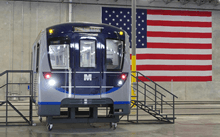The island of Oahu has a population of nearly one million residents1 and a strong tourism industry, welcoming more than 400,000 visitors annually2. Transportation experts have struggled to reduce traffic congestion on the H-1 freeway for decades. The solution was constructing a high-capacity rapid transit to connect the heavily congested east-west transportation corridor.
As the local population grew, so did the time drivers were forced to waste navigating an increasingly noisy and congested commute on one of the most clogged roadways in America. “We have probably more cars registered here than we do people,” said Honolulu’s mayor, Rick Blangiardi. And because Honolulu is situated on Oahu, an island where roadways are fixed between the ocean and the mountains, that added a further constraint on travel. When something went wrong, transportation authorities couldn’t divert traffic to alternative routes like their counterparts on the mainland. “It’s a big challenge because of the limitations of our road system, which is why the advent of rail has been long overdue,” Blangiardi pointed out.
But big changes are afoot as Honolulu builds out the first fully autonomous elevated rail network in the U.S. with Hitachi’s help.
The Skyline – as the new metro line is called – is a bold mass transit project that promises to usher in a new era of cleaner, more punctual, and energy-efficient transit alternatives to manually driven railroads and subways. The project, which is unfolding in 3 phases of development, opened its first 11-mile segment on June 30th, 2023, between the nine stations from East Kapolei to Aloha Stadium. Additional stations will be built along the rail line, including the Joint Base Pearl Harbor-Hickam and the Daniel K. Inouye International Airport, slated for passenger service in the summer of 2025. The trains, which are all electrically powered, are air-conditioned, feature Wi-Fi, and have ample space for bicycles, surfboards, baby strollers, luggage, and more. The trains are fully compliant with the Americans with Disabilities Act (ADA) and have dedicated spaces for wheelchairs, allowing passengers to move on and off the trains easily.

Project participants excitedly describe a future transportation network that will ultimately be able to move thousands of people to work, shopping, and recreation destinations safely and rapidly. Rail is fully integrated with the city bus system. Passengers use a single system-wide transit smart card to move seamlessly between the bus and the rail. “This will be a showcase for the nation,” said Roger Morton, the Director of Transportation Services for the city and county of Honolulu. “This will really show how we can use public transportation to make a city go from being a great city to an even greater city.”
As island dwellers, Honolulu residents face unique challenges. Sea level rise, which poses an acute threat due to climate change, has been increasingly manifesting for over a decade. The region is also susceptible to hurricanes, and tsunamis. That backdrop added further urgency to find ways to reduce the contribution of traditional transportation to the city’s overall carbon footprint. (Local officials estimate that traditional transportation constitutes about 20% of Honolulu’s carbon footprint.) By 2025, the island of Oahu aims to transition to renewable energy, reducing its greenhouse gas emissions by 45% with the intent of becoming fully carbon-neutral by 2045.3
Here’s where Hitachi Rail is helping local officials realize their goals. One train can fit approximately eight hundred passengers, which is the equivalent of about ten city buses, according to Lori Kahikina, the Executive Director, and Chief Executive Officer of the Honolulu Authority for Rapid Transportation (HART). “So, if we can get that many vehicles off the road and get all those people riding in the train, it helps with reducing the use of fossil fuels and the number of cars on the roads.”

With the implementation of the Skyline Rail project, Honolulu now has a green transportation alternative to approx. 40,000 car trips4 that people take each day. Fewer autos on the road reduce traffic jams and reduce fossil fuel use, thus cutting the overall amount of auto pollution in the atmosphere. At the same time, the new train line will serve as a magnet for urban planners to design transit-oriented development nearby, helping to conserve and protect the island’s delicate ecosystem.
The big benefit of a fully automated system is safety, an area that Hitachi’s trains take to a new level. With Hitachi’s autonomous train system, the element of human error is removed from the equation. Before being put into service, all the trains must pass rigorous safety testing and certification procedures. Passengers can contact the train's operational control center on the train and at the station via emergency telephones. More than 1,500 cameras are also connected to the control center, enabling train controllers to immediately share information with first responders in the event of an accident or other emergency. “Hitachi has a global record of experience in commissioning driverless systems that are best in class. The vehicle's automatic train system utilizes the latest technology to ensure passenger, vehicle, and system safety” said Domenico Fortinguerra, Project Director, Hitachi Rail Honolulu.

Without an experienced rail partner, the island would have been hard-pressed to implement such a complex and sophisticated solution. Located in the middle of the Pacific Ocean, Oahu is of volcanic origin and consists mainly of a broad interior valley situated between the Waianae and Koolau mountain ranges. “And so, it makes it a 45-mile-long city that's only three and a half miles wide,” said Morton. Morton noted that the only way to provide mobility to a million people in the greater Honolulu area was a high-capacity rail system “down a corridor on the leeward side of all of our mountains."
But with its widespread reach and tremendous experience in public transportation, Hitachi possessed both the global scale as well as the knowledge to help Honolulu navigate through the deployment process. Hitachi’s rail system provides an unmatched level of service reliability. The project achieved a remarkable 99.6% level of schedule adherence within the first few month of operations. That level of precision offers the greater Honolulu community a system they can rely upon. “Hitachi has been phenomenal in maintaining that 99.6% serviceability percentage,” said Kahikina. “In the transit industry, 99.6% is unheard of. You’re lucky if you're in the low nineties. So, for Hitachi to maintain that day after day, week after week, it's incredible.”
“I don't think I could have been any more impressed,” Blangiardi added. “They're global thinkers, and that's a great perspective to draw down on. And at the same time, it's been really reassuring to work with professionals who really know their business. And it's given me a lot of confidence. Hitachi has been the perfect partner for us.”
Looking ahead to the project’s completion, Blangiardi says the rail transit system will provide a myriad of benefits to residents, who can take advantage of an easy and affordable commute that links the island more closely. “This is a value proposition that most people who are alive today don't even understand,” he said. “And that's the exciting part about building this because it will affect future generations, and only for the good.”
To find out more about how Hitachi Rail can help you, visit https://www.hitachirail.com/ or https://www.hitachirail.com/careers/
1Hawaii Population 2024, World Population Review, https://worldpopulationreview.com/states/hawaii-population
2Visitor expenditures decreased for November 2023 compared to November 2022, Hawaii Tourism Authority, https://www.hawaiitourismauthority.org/media/12135/november-2023-visitor-statistics-final.pdf
3One Climate One Oʻahu Climate Action Plan 2020-2025, Aloha+ Challenge, https://alohachallenge.hawaii.gov/pages/spotlight-one-climate-one-oahu-climate-action-plan
4US' First Fully Autonomous Urban Railway System, Built by Hitachi Rail, Opens in Honolulu, https://www.hitachi.us/press/us-first-fully-autonomous-urban-railway-system-built-by-hitachi-rail-opens-in-honolulun







